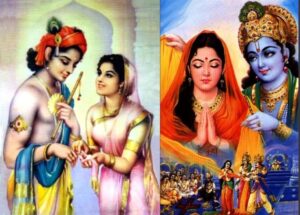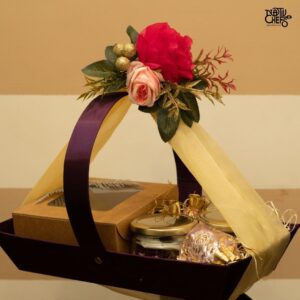
Brothers and sisters are like cats and dogs!! We fight, we laugh, but most importantly, we share a unique bond that can never break easily. It’s an ‘invisible promise’ that keeps living and is unbreakable. India celebrates this relationship in an illustrious manner, which Rakshabandhan or Rakhi.
 Moreover, Raksha Bandhan falls in the auspicious month of Shravana and occurs on the full moon day (Purnima) according to the Hindu Lunar calendar. Also known as Rakhi Purnima, many states of India celebrate this festival. It’s known with several names, but the common thing is the prayer and the pledge for protection. In South India, Raksha Bandhan is called Avani Avittam in North India, it’s known as Kajari Purnima, and in the Western Ghats of India, it’s called Nariyal Purnima.
Moreover, Raksha Bandhan falls in the auspicious month of Shravana and occurs on the full moon day (Purnima) according to the Hindu Lunar calendar. Also known as Rakhi Purnima, many states of India celebrate this festival. It’s known with several names, but the common thing is the prayer and the pledge for protection. In South India, Raksha Bandhan is called Avani Avittam in North India, it’s known as Kajari Purnima, and in the Western Ghats of India, it’s called Nariyal Purnima.
However, Rakshabandhan’s origin has a vast and varied story. Several stories connote this festival’s significance. Some are-
- During the battle in Mahabharata, Lord Krishna hurt his finger after sending his ‘Sudarshan Chakra’ to behead Shishupala. Seeing this, Draupadi bandaged his finger with a piece of cloth from her saree. The bandage symbolises a promise that Krishna made to Draupadi to protect her at any cost. Lord Krishna’s help was quick when Draupadi was in need. In a rigged game of dice, Yudhistira wagers Draupadi but loses her. The Kauravas took advantage of it and tried to disrobe her. As the Pandavas couldn’t help her, she prayed for Krishna’s help. As the Kauravas proceed to unclothe her, the saree kept getting longer and was never-ending. Hence, this is known as Krishna’s miracle to protect Draupadi and is carried forward to other stories.
 In a war between demons and gods, Demon King Brutra was advancing, and Gods lead by lord Indra were on the verge of defeat. After approaching Guru Brihaspati for advice, Lord Indra tied a sacred thread on his wrist powered by divine incantations. Lord Indra’s Queen Sanchi (Indrani) empowered the filament and tied it to his hand, leading them to victory.
In a war between demons and gods, Demon King Brutra was advancing, and Gods lead by lord Indra were on the verge of defeat. After approaching Guru Brihaspati for advice, Lord Indra tied a sacred thread on his wrist powered by divine incantations. Lord Indra’s Queen Sanchi (Indrani) empowered the filament and tied it to his hand, leading them to victory.- After winning three worlds from the Demon King Bali, Lord Vishnu was to stay with him. However, Goddess Lakshmi wanted to return to her home place, Vaikuntha. Hence, she tied a rakhi around Bali’s wrist, making him a brother. In return, she asked Bali to release Lord Vishnu from his vow and allow him to return to Vaikuntha with her. King Bali agreed to the request, and Lord Vishnu returned to his wife, Lakshmi.
- According to folklore, not having a sister on the eve of Rakhi was frustrating for Shubh and Labh, Lord Ganesha’s two sons. After obliging to their request, Ganesha created Santoshi Maa from the divine flames.
- Another tall tale conveys the story of Yama and Yamuna. Yama did not visit his sister, Yamuna, for 12 years, ultimately making her sad. After taking advice from Ganga, Yama met his sister. She was glad that he came and took care of him. Seeing this hospitality from Yamuna, Yama asked her for a gift, to which Yamuna said that she wanted to keep meeting her brother.
Although the times have changed, the festival’s tradition and customs have been the same. Before the festival, girls browse through different shops, searching for the perfect Rakhi and sweets. Its significance varies from region to region, it’s primarily a North and West Indian festival, but it also has different importance in Southern and Coastal areas. Some are-

- In the Western Ghats, locals consider it an offering to Lord Varuna, Lord of the Sea. The people offer coconuts to Lord Varuna by throwing them into the sea as a ritual. Hence, they call it Narali Purnima, which also marks the beginning of the fishing season.
- South Indians call it Avani Avittam, which is highly significant to Brahmins. After taking a holy bath in the morning, Brahmins change their sacred thread (Janeyu) while chanting mantras. The yarn is a representation of the vow to adhere to the Vedic culture. They also take part in a pledge to perform their duties as Brahmin. Also known as Shravani or Rishi Tarpan, all Brahmins take part in it.
- In North India, Rakhi is known as Kajari Purnima. After sowing the seeds of wheat and barley, people worship Goddess Bhagwati and ask her blessings for a good harvest.
- Pavitropana is a different type of celebration in Gujarat. On Rakhi Purnima, devotees offer water to Shivalinga and pray for forgiveness. The ritual also includes tying cotton threads soaked in ‘Panchagaivya‘(mixture of Cow’s ghee, milk, curd, urine, and excreta).
- In West Bengal, locals perform the prayers of Lord Krishna and Radha. Known as Jhulan Purnima, sisters tie Rakhi to brothers and wish for their immortality.

With a vibrant celebration, meetha khaana toh banta hai!! There are several delicacies to try on this festive day!! For example, in Avani Avittam, South Indians gorge on unique delicacies like Varagu Thattai (a snack made of millets ), Aval Payasam (Poha Kheer), Spicy Murukku, Unni Appam, and many others. Whereas on Narali Purnima, coconut is the staple food during the day. Delicacies like Narali Bhaat (Coconut rice), Naral barfi (Coconut barfi), and Naral Laddu (Coconut laddu) are the main attractions during the day. However, in contemporary times, chocolates and traditional mithais have also emerged as popular gifting options during Raksha Bandhan with attractive Rakhi hampers.
Let the bond between siblings stay unimpaired. We wish everyone a Happy and safe Raksha Bandhan!!
